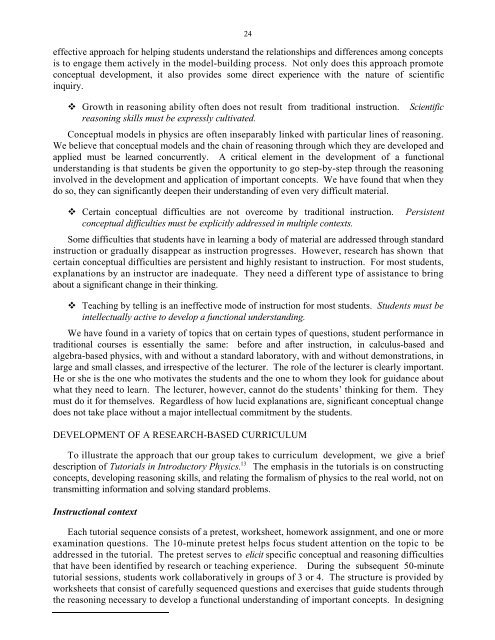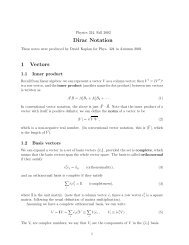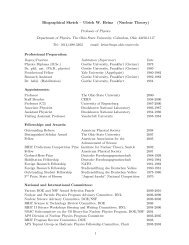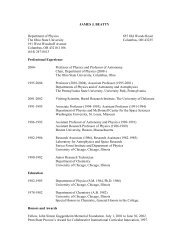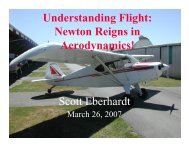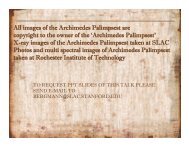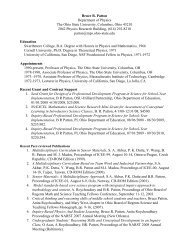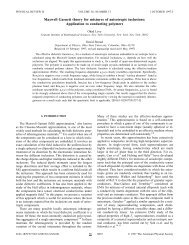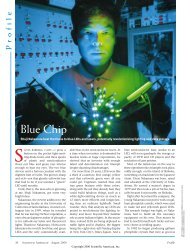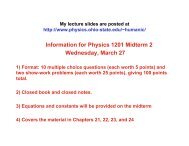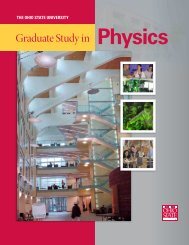Brasil Final Report - Department of Physics - The Ohio State University
Brasil Final Report - Department of Physics - The Ohio State University
Brasil Final Report - Department of Physics - The Ohio State University
Create successful ePaper yourself
Turn your PDF publications into a flip-book with our unique Google optimized e-Paper software.
24<br />
effective approach for helping students understand the relationships and differences among concepts<br />
is to engage them actively in the model-building process. Not only does this approach promote<br />
conceptual development, it also provides some direct experience with the nature <strong>of</strong> scientific<br />
inquiry.<br />
Growth in reasoning ability <strong>of</strong>ten does not result from traditional instruction. Scientific<br />
reasoning skills must be expressly cultivated.<br />
Conceptual models in physics are <strong>of</strong>ten inseparably linked with particular lines <strong>of</strong> reasoning.<br />
We believe that conceptual models and the chain <strong>of</strong> reasoning through which they are developed and<br />
applied must be learned concurrently. A critical element in the development <strong>of</strong> a functional<br />
understanding is that students be given the opportunity to go step-by-step through the reasoning<br />
involved in the development and application <strong>of</strong> important concepts. We have found that when they<br />
do so, they can significantly deepen their understanding <strong>of</strong> even very difficult material.<br />
Certain conceptual difficulties are not overcome by traditional instruction. Persistent<br />
conceptual difficulties must be explicitly addressed in multiple contexts.<br />
Some difficulties that students have in learning a body <strong>of</strong> material are addressed through standard<br />
instruction or gradually disappear as instruction progresses. However, research has shown that<br />
certain conceptual difficulties are persistent and highly resistant to instruction. For most students,<br />
explanations by an instructor are inadequate. <strong>The</strong>y need a different type <strong>of</strong> assistance to bring<br />
about a significant change in their thinking.<br />
Teaching by telling is an ineffective mode <strong>of</strong> instruction for most students. Students must be<br />
intellectually active to develop a functional understanding.<br />
We have found in a variety <strong>of</strong> topics that on certain types <strong>of</strong> questions, student performance in<br />
traditional courses is essentially the same: before and after instruction, in calculus-based and<br />
algebra-based physics, with and without a standard laboratory, with and without demonstrations, in<br />
large and small classes, and irrespective <strong>of</strong> the lecturer. <strong>The</strong> role <strong>of</strong> the lecturer is clearly important.<br />
He or she is the one who motivates the students and the one to whom they look for guidance about<br />
what they need to learn. <strong>The</strong> lecturer, however, cannot do the students’ thinking for them. <strong>The</strong>y<br />
must do it for themselves. Regardless <strong>of</strong> how lucid explanations are, significant conceptual change<br />
does not take place without a major intellectual commitment by the students.<br />
DEVELOPMENT OF A RESEARCH-BASED CURRICULUM<br />
To illustrate the approach that our group takes to curriculum development, we give a brief<br />
description <strong>of</strong> Tutorials in Introductory <strong>Physics</strong>. 13 <strong>The</strong> emphasis in the tutorials is on constructing<br />
concepts, developing reasoning skills, and relating the formalism <strong>of</strong> physics to the real world, not on<br />
transmitting information and solving standard problems.<br />
Instructional context<br />
Each tutorial sequence consists <strong>of</strong> a pretest, worksheet, homework assignment, and one or more<br />
examination questions. <strong>The</strong> 10-minute pretest helps focus student attention on the topic to be<br />
addressed in the tutorial. <strong>The</strong> pretest serves to elicit specific conceptual and reasoning difficulties<br />
that have been identified by research or teaching experience. During the subsequent 50-minute<br />
tutorial sessions, students work collaboratively in groups <strong>of</strong> 3 or 4. <strong>The</strong> structure is provided by<br />
worksheets that consist <strong>of</strong> carefully sequenced questions and exercises that guide students through<br />
the reasoning necessary to develop a functional understanding <strong>of</strong> important concepts. In designing


